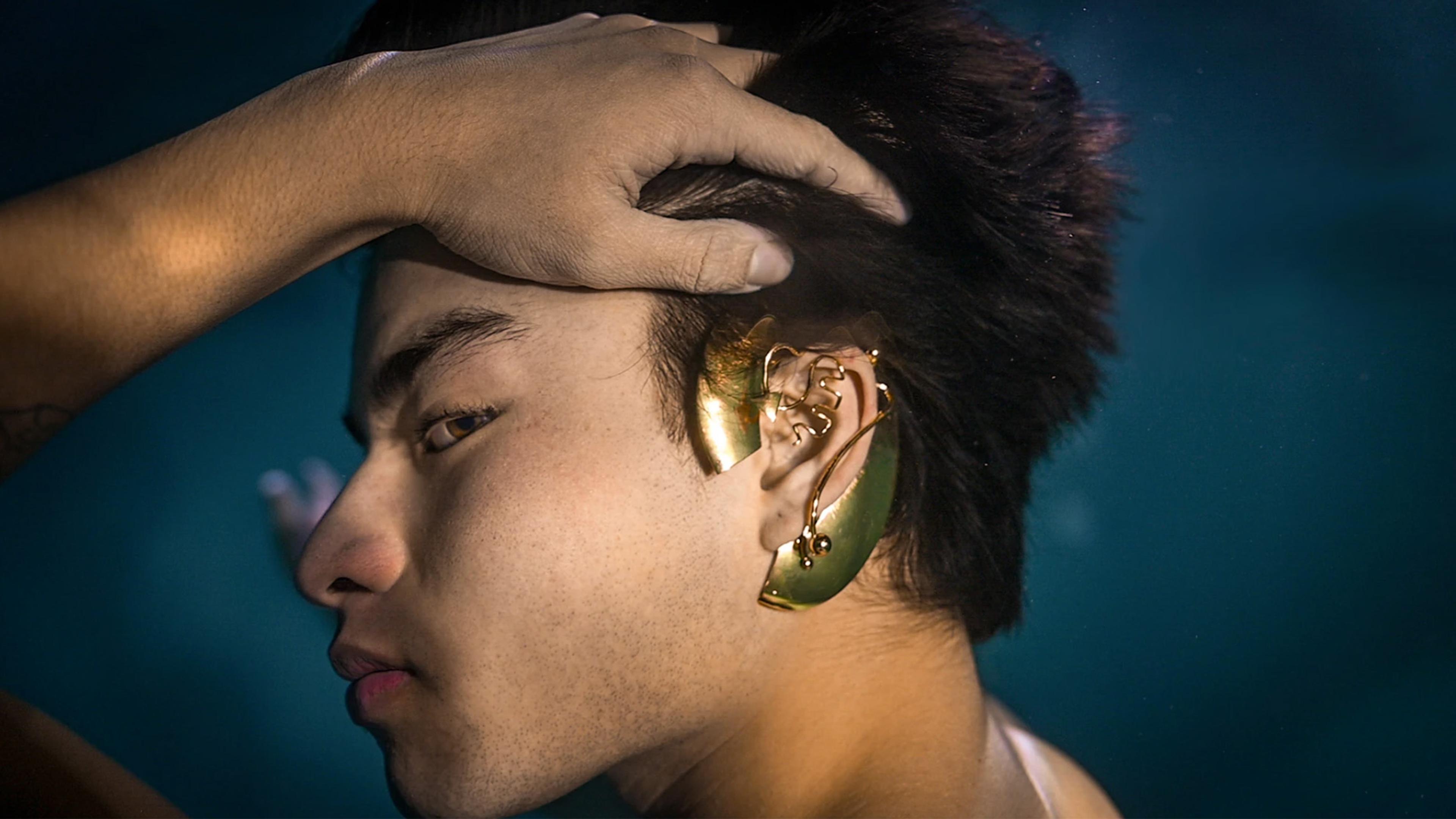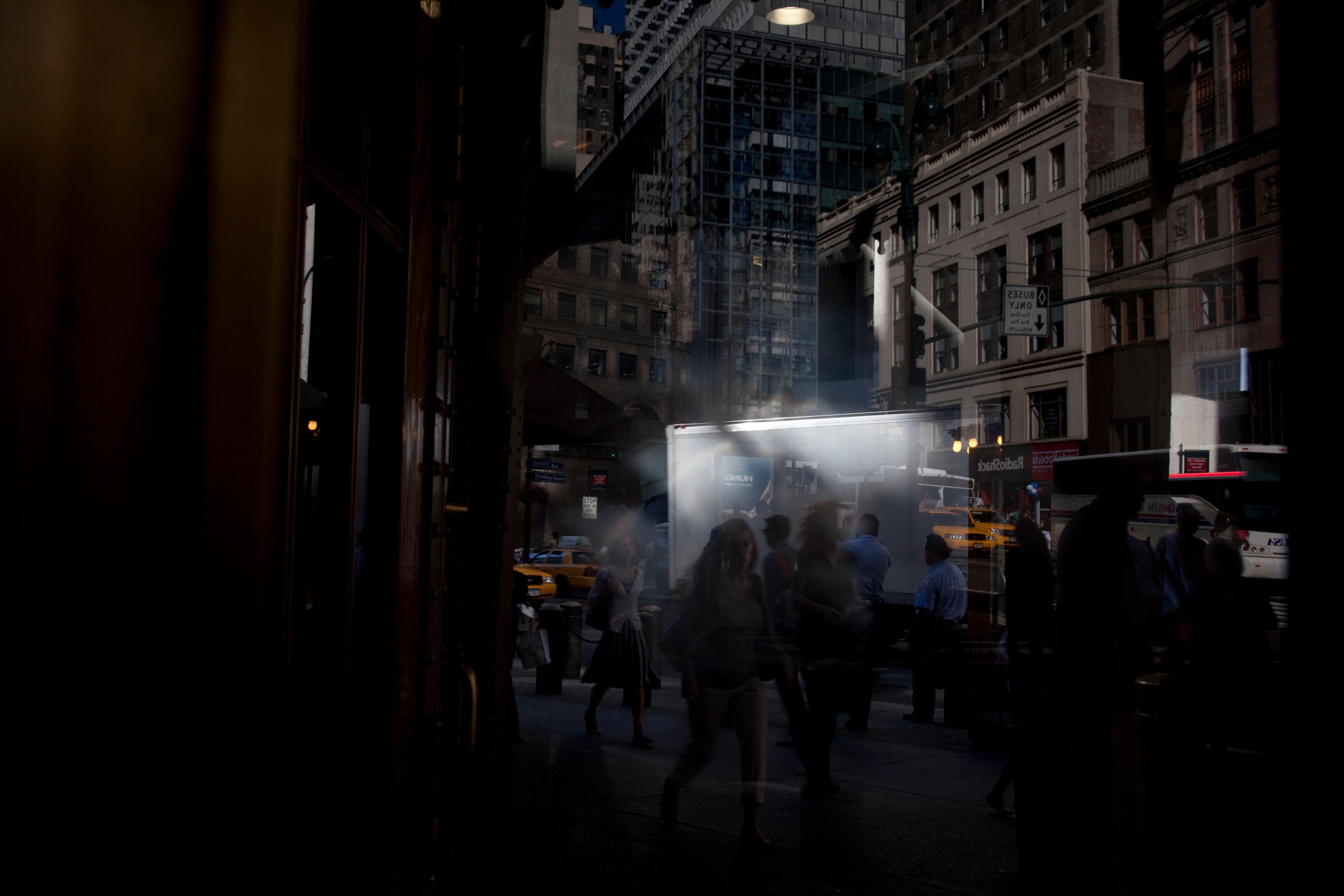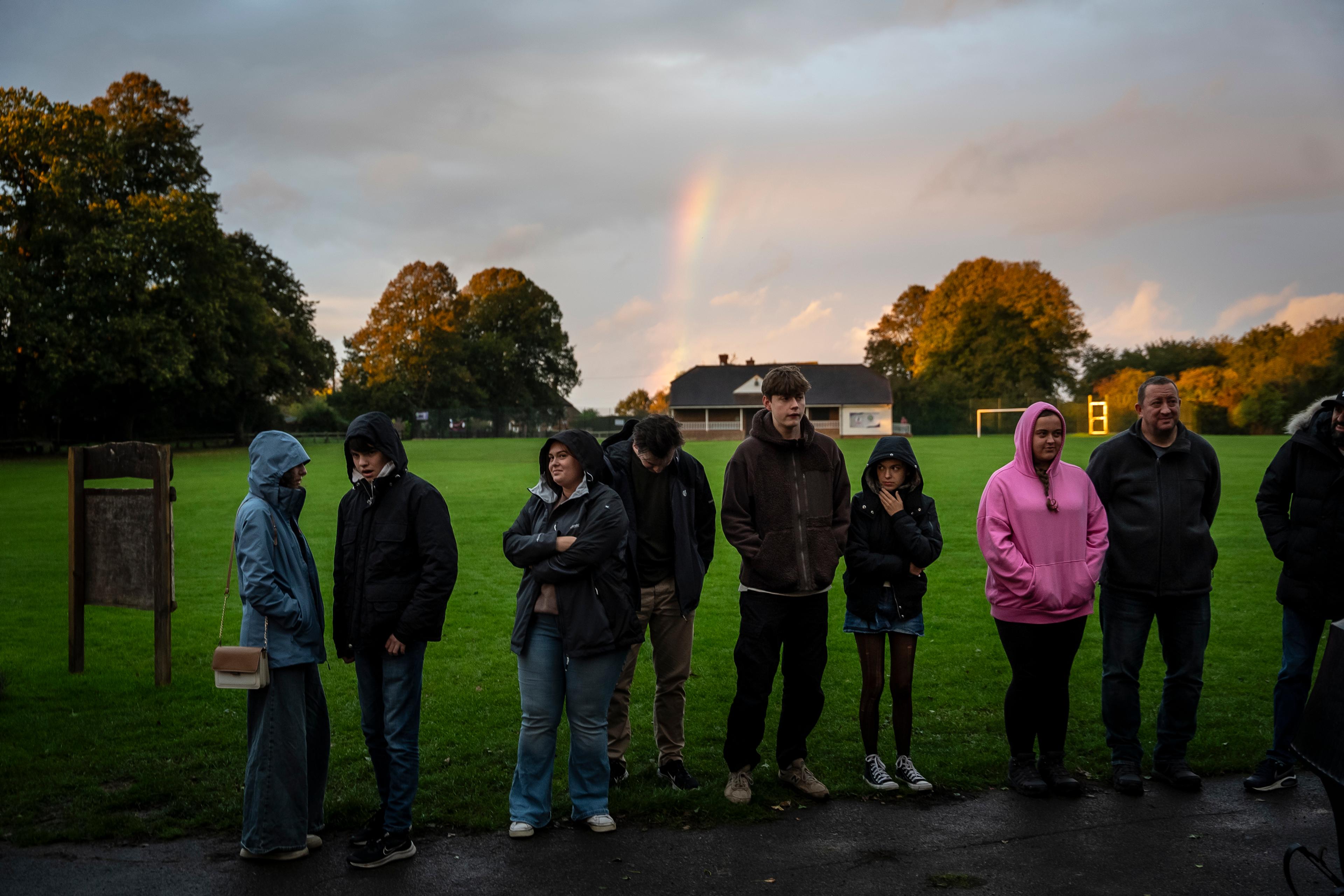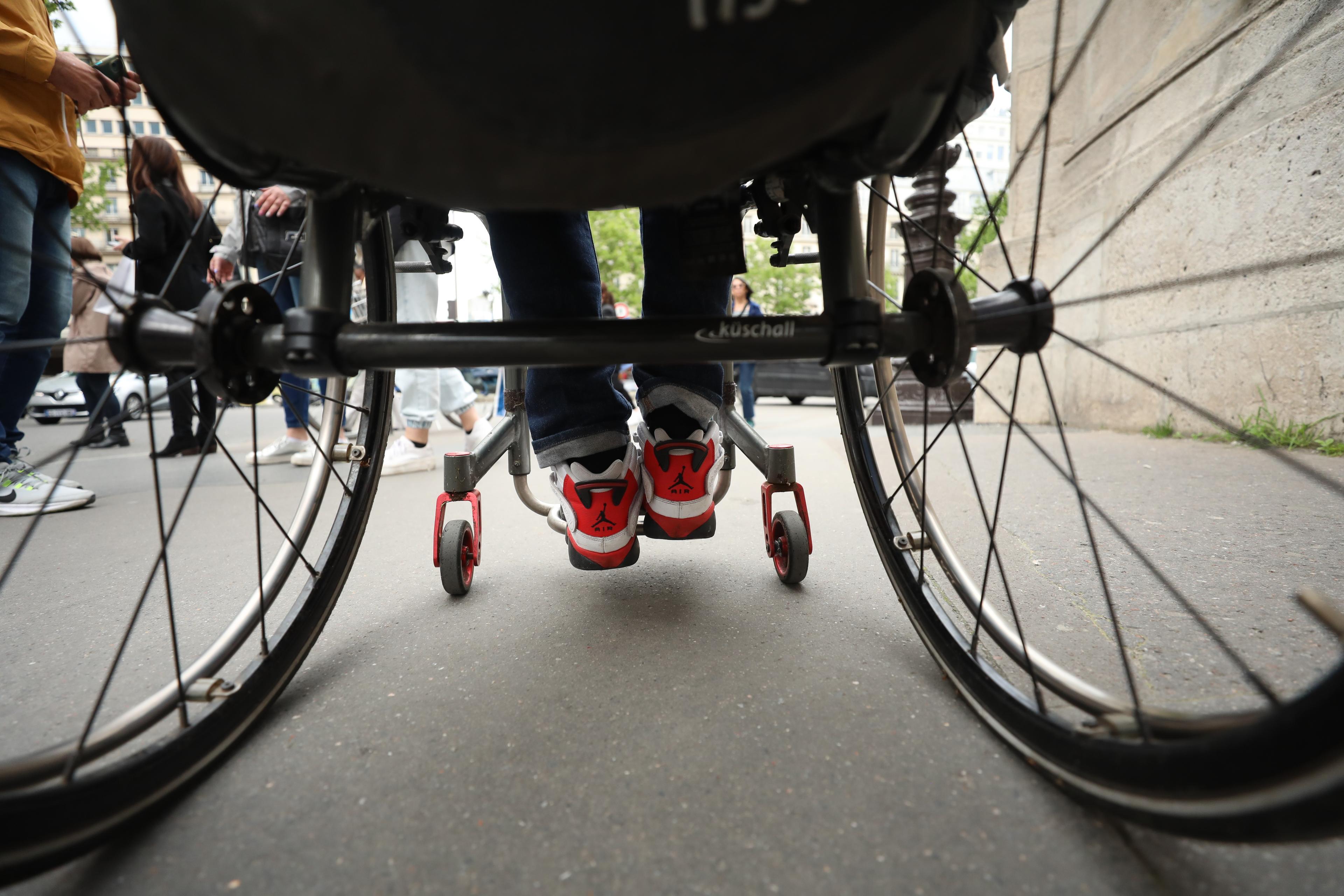A two-minute newsreel produced by British Pathé in 1957 spotlights how far electric hearing aids have advanced from mechanical ear trumpets. In one scene, a stylist attends to a blonde woman, placing a rhinestone accessory over a hearing aid earpiece in the woman’s right ear. ‘Modern hearing aids,’ the narrator explains, ‘like these rhinestone earrings, are often glamorous accessories that are fashionable as well as efficient.’ The music soars as the stylist secures the accessory, then the camera pans to show her parting the woman’s hair to reveal a hearing aid receiver hidden underneath. Modern hearing aids, it seems, can be glamorous, but they are nevertheless still required to be inconspicuous.
Hearing aids have always been designed to be concealed. Ear trumpets in the 19th century were obscured within walking sticks, fans or hats, while early 20th-century vacuum tube hearing aids were sold with accessories for camouflaging wires and earpieces. The inventions of the transistor, the printed circuit board and the watch battery – which emerged from Second World War research – advanced hearing aid design: the microphone, amplifier and button-cell battery could be built on a single unit (the ‘monopak’) that would drastically reduce in size during the postwar years. Units were built into headbands, tie clips, barrettes, watches, pens and, by 1955, into spectacle frames; by the 1980s, nearly all transistor hearing aids morphed into behind-the-ear and in-the-ear models, at the same time that cochlear implants – placed surgically under the skin – were becoming widely available.
The design trend towards miniaturisation, however, didn’t displace aesthetics. In 1949, Paravox developed body-worn vacuum tube hearing aids with a brushed aluminium chassis and gold filigree microphone grills; Sonotone’s 1940s models featured gold Art Deco clips; and one of Zenith’s bestselling transistor hearing aids was their gold ‘Royal’ model of 1952. The range of colours and styles indicates that designers knew aesthetics would appeal to customers but, paradoxically, the promotional and instruction booklets sold alongside hearing aids still advised how best to camouflage the device on the user’s body or clothes. Images of people in a state of undress, with wires and harnesses to keep their instrument in place, suggest that, whatever the beauty attracting a customer to a hearing aid model in the first place, it wasn’t meant to be visible to others – and yet, managing how the aid would be worn still required adhering to cultural expectations of gendered performance and beauty. For instance, one of Sonotone’s booklets, Fashion: Your Passport to Poise (1950), advised young, fashionable women how to maintain their glamorous selves without compromising the functionality of their hearing aids. The stylish Sonotone woman, then, was required to care about her visible self by carefully managing her ‘deaf face’ – the strained expression of worry and struggle to hear – and present herself instead as a confident, alert and happy person. Revealing one’s deafness was seen as unattractive.
Invisibility remained a desirable goal for hearing aid design; and thus, by the 1990s, the ‘boring beige’ became standard for ‘disappearing’ the device against the skin. This emphasis on invisibility is deeply rooted in American cultural expectations of normality and conformity. Historically, deaf people have been expected to assimilate into the hearing culture. The banning of sign language in schools from 1880 until 1980, the forced institutionalisation of deaf people for no reason other than their lack of hearing, the denial of their civil rights (such as the right to drive) in some countries, and even stereotypical caricatures of deafness have subjected deaf people to discriminatory treatment. The rise of precise surgical and technological ‘cures’ for hearing loss in the 20th century further conveyed expectations for deaf people to ‘fix’ themselves and marginalised those who did not, or could not.
I used to be incredibly embarrassed by my hearing aids. They helped me hear and aided my speech-reading; but, no matter how well I concealed them in my hair or sought out different medical ‘fixes’, they were a reminder of the fact I am deaf and could never be ‘normal’. I could carefully manage my self-presentation and attempt to ‘pass’ as hearing, but at regular intervals be betrayed by the whistling sounds coming from my aids – the acoustic feedback that occurs when the aid is loose or not placed in properly: a sound that I couldn’t hear, but that seemed to offend hearing people. Exhausted from constantly trying to appease those around me, I got over this embarrassment in adulthood, and slowly began to accept that my deafness couldn’t always be invisible. After all, I had no control over the tech features of my hearing aids.
Culture influences technological design. What happens, then, if we change our expectations? If we stop stigmatising disability and see beauty in difference?
In Design Meets Disability (2009), the former designer Graham Pullin argues that the design priority for medical devices has ‘been less about projecting a positive image than about trying not to project an image at all.’ Yet, if spectacles have merged fashion with functionality to emerge as accessory eyewear, then why not hearing aids? Pullin’s explanation is that the hearing aid industry’s preoccupation with technological development has sidelined design, as has the longstanding ableism against deaf people, which pressures them to disguise their hearing aids. If discretion is no longer a design priority, then hearing aids could become as fashionable as eyewear, but this requires a fundamental shift in how product design is applied for medical and assistive technologies.
Beginning with the sleek, industrial aesthetic of digital hearing aids developed in the 2000s, designers have reconceptualised the shape of hearing aids, borrowing features from modern architecture, jewellery and even automotive design. Yet their central focus is still discretion. The chromed metal, high-gloss Zon Hearing Aid (2008) designed by Stuart Karten Design, received the Cooper Hewitt, Smithsonian Design Museum’s People’s Design Award for its visual appeal; yet the product description highlights that the palette of six colours are still designed to be ‘virtually invisible when worn’. Likewise, the hearing system Brite (2007) from the Swiss company Bernafon was awarded a prestigious Red Dot design award for their reinvention of hearing instruments into a ‘distinctive, yet discreet design’.
Other design prototypes have aimed to transform hearing aids to personalised accessories, including the New York artist Elana Langer’s Swarovski-encrusted Earring Aid (2014), the Facett hearing aid (2018) from Australia which is modelled after the geometrical shape of crystals, and other ‘cool’ designs, including ear gauges, music visualisers and eyeglasses. These prototypes, however, are suitable only for people with mild hearing loss, rather than across the auditory spectrum. Even Alice Turner’s Amplify, a ‘socially inclusive design’ that received rave reviews, is reliant on bone conduction technology. None of these designs would fit my severe-profound deafness, that is, 98 per cent loss in both ears, and, for most deaf users, these prototypes are expensive and often not covered by insurance.
In Making Disability Modern (2020), Bess Williamson and Elizabeth Guffey’s ‘design model of disability’ argues that, rather than focusing on how technology cures or rehabilitates, we need to emphasise the agency or identity that materialises between users and their assistive device. By shifting from discretion to assertion, design becomes about reclaiming and fostering identity. Custom-made options for coloured chassis or earmoulds, skin covers, and charms and stickers for tubes have been available through manufacturers for users to personalise their hearing aids or cochlear implants. There are numerous online instructions for creating DIY ‘hearrings’ – some even created by a 10-year-old – or available to buy on Etsy.
There are bolder approaches too. The Australian designer Lauren Regolini collaborated with the Telethon Speech & Hearing company as well as jewellery and fashion designers to create stylish, stand-out accessories for hearing aids. The American designer Ray Fontaine partnered with Embrace Hearing to create HearCuff: interchangeable, decorative ear accessories. The Deafmetal company in Finland transforms hearing devices into personalised jewellery. More recently, the deaf model Chella Man partnered with the genderless streetwear brand Private Policy New York to create gold-plated ear cuffs that are meant to accentuate the hearing device or cochlear implants. The collaboration was released alongside Man’s three-minute film, The Beauty of Being Deaf (2021), which conceptualises his need to amplify deaf identity and explores how ‘redefining the machinery with [his] art replaced the rigidity with fluidity’.
Expanding the breadth of hearing aid design beyond discretion opens possibilities for imagining how fashion and style merge to celebrate, rather than diminish, deaf identity. Some people prefer concealable aids, and that’s OK too; deaf experience is a spectrum and there’s no one way of being deaf. However, moving away from the expectation that assistive technologies need to be concealed or minimised requires a shift in how we perceive disability. That is, disability isn’t the opposite of ability. It’s a variation in the human condition, a boundless way of interacting in the world. It’s beauty in all forms, but it’s underrepresented and stigmatised in the media. Shifting our expectations for design-as-discretion will thus radically transform how disabled people are represented in society, and disintegrate ableist stereotypes.
For instance, watching Lady Gaga perform at the inauguration of Joe Biden in January, I noticed that she was wearing a gold earpiece with a stunning leaf design. I knew this was her audio monitor as typically worn by musicians but wondered why such designs aren’t applicable or mainstream for hearing aid and cochlear implant-wearers. By listening to deaf people’s desires, the future of hearing aid design will certainly be a remarkable, positive and celebratory affirmation of deafness.








